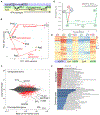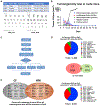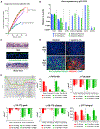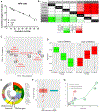Long-Term In Vitro Expansion of Epithelial Stem Cells Enabled by Pharmacological Inhibition of PAK1-ROCK-Myosin II and TGF-β Signaling
- PMID: 30332641
- PMCID: PMC6284236
- DOI: 10.1016/j.celrep.2018.09.072
Long-Term In Vitro Expansion of Epithelial Stem Cells Enabled by Pharmacological Inhibition of PAK1-ROCK-Myosin II and TGF-β Signaling
Abstract
Despite substantial self-renewal capability in vivo, epithelial stem and progenitor cells located in various tissues expand for a few passages in vitro in feeder-free condition before they succumb to growth arrest. Here, we describe the EpiX method, which utilizes small molecules that inhibit PAK1-ROCK-Myosin II and TGF-β signaling to achieve over one trillion-fold expansion of human epithelial stem and progenitor cells from skin, airway, mammary, and prostate glands in the absence of feeder cells. Transcriptomic and epigenomic studies show that this condition helps epithelial cells to overcome stresses for continuous proliferation. EpiX-expanded basal epithelial cells differentiate into mature epithelial cells consistent with their tissue origins. Whole-genome sequencing reveals that the cells retain remarkable genome integrity after extensive in vitro expansion without acquiring tumorigenicity. EpiX technology provides a solution to exploit the potential of tissue-resident epithelial stem and progenitor cells for regenerative medicine.
Keywords: PAK1/ROCK/Myosin II; TGF-β; cell culture method; cell therapy; epithelial stem and progenitor cells; feeder-free; regenerative medicine.
Copyright © 2018 The Author(s). Published by Elsevier Inc. All rights reserved.
Figures






Similar articles
-
Long-Term Expansion of Mouse Primary Epidermal Keratinocytes Using a TGF-β Signaling Inhibitor.Methods Mol Biol. 2025;2922:49-62. doi: 10.1007/978-1-0716-4510-9_4. Methods Mol Biol. 2025. PMID: 40208526
-
Differential response of epithelial stem cell populations in hair follicles to TGF-β signaling.Dev Biol. 2013 Jan 15;373(2):394-406. doi: 10.1016/j.ydbio.2012.10.021. Epub 2012 Oct 26. Dev Biol. 2013. PMID: 23103542
-
TGF-β signaling in stromal cells acts upstream of FGF-10 to regulate epithelial stem cell growth in the adult lung.Stem Cell Res. 2013 Nov;11(3):1222-33. doi: 10.1016/j.scr.2013.08.007. Epub 2013 Aug 28. Stem Cell Res. 2013. PMID: 24029687
-
Feeder Layer Cell Actions and Applications.Tissue Eng Part B Rev. 2015 Aug;21(4):345-53. doi: 10.1089/ten.TEB.2014.0547. Epub 2015 Mar 24. Tissue Eng Part B Rev. 2015. PMID: 25659081 Free PMC article. Review.
-
Regenerating human epithelia with cultured stem cells: feeder cells, organoids and beyond.EMBO Mol Med. 2018 Feb;10(2):139-150. doi: 10.15252/emmm.201708213. EMBO Mol Med. 2018. PMID: 29288165 Free PMC article. Review.
Cited by
-
Steps toward Cell Therapy for Cystic Fibrosis.Am J Respir Cell Mol Biol. 2020 Sep;63(3):275-276. doi: 10.1165/rcmb.2020-0235ED. Am J Respir Cell Mol Biol. 2020. PMID: 32648785 Free PMC article. No abstract available.
-
Identification of myosin II as a cripto binding protein and regulator of cripto function in stem cells and tissue regeneration.Biochem Biophys Res Commun. 2019 Jan 29;509(1):69-75. doi: 10.1016/j.bbrc.2018.12.059. Epub 2018 Dec 20. Biochem Biophys Res Commun. 2019. PMID: 30579599 Free PMC article.
-
ROCK inhibitor combined with Ca2+ controls the myosin II activation and optimizes human nasal epithelial cell sheets.Sci Rep. 2020 Oct 8;10(1):16853. doi: 10.1038/s41598-020-73817-3. Sci Rep. 2020. PMID: 33033339 Free PMC article.
-
Establishment of Primary Transgenic Human Airway Epithelial Cell Cultures to Study Respiratory Virus-Host Interactions.Viruses. 2019 Aug 13;11(8):747. doi: 10.3390/v11080747. Viruses. 2019. PMID: 31412613 Free PMC article.
-
Rapid bioprinting of conjunctival stem cell micro-constructs for subconjunctival ocular injection.Biomaterials. 2021 Jan;267:120462. doi: 10.1016/j.biomaterials.2020.120462. Epub 2020 Oct 23. Biomaterials. 2021. PMID: 33129190 Free PMC article.
References
-
- Avior Y, Sagi I, and Benvenisty N (2016). Pluripotent stem cells in disease modelling and drug discovery. Nat. Rev. Mol. Cell Biol 17, 170–182. - PubMed
Publication types
MeSH terms
Substances
Grants and funding
LinkOut - more resources
Full Text Sources
Other Literature Sources
Medical
Molecular Biology Databases
Research Materials

